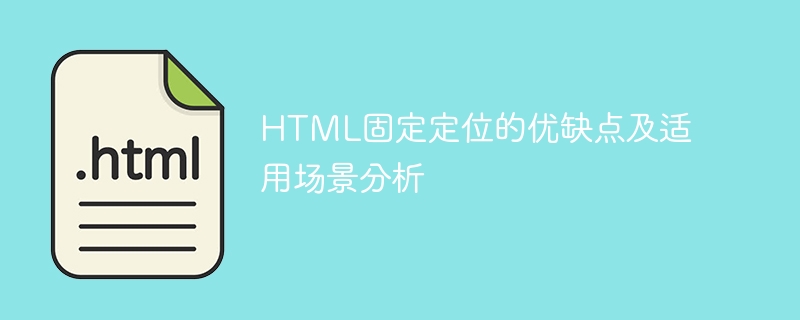Home >Web Front-end >HTML Tutorial >Analyze the advantages, disadvantages and applicable scenarios of HTML fixed positioning
Analyze the advantages, disadvantages and applicable scenarios of HTML fixed positioning
- WBOYWBOYWBOYWBOYWBOYWBOYWBOYWBOYWBOYWBOYWBOYWBOYWBOriginal
- 2024-01-20 10:46:121408browse

Analysis of the advantages, disadvantages and applicable scenarios of HTML fixed positioning
In HTML, we often need to fix an element at a certain position on the page, so that no matter No matter how the user scrolls the page, the element will remain in a fixed position and will not change position as the page scrolls. In order to achieve this effect, HTML provides fixed positioning (position: fixed) attribute.
The advantages of fixed positioning are as follows:
- Improve user experience: fixed positioning can make certain important elements (such as navigation bars, advertising columns, etc.) always visible, regardless of page scrolling The impact allows users to quickly access important content and improves the user’s browsing experience.
- Enhance page visual effects: Through fixed positioning, you can achieve some unique page effects, such as creating a floating sidebar, suspended sharing buttons, etc., to increase the interactivity and attractiveness of the page.
- Convenient page layout: fixed positioning can make an element escape the constraints of the document flow and will not affect the arrangement of other elements. In this way, we can layout the page more flexibly, making the page structure clearer and more reasonable.
The disadvantages of fixed positioning are as follows:
- Compatibility issues: Since fixed positioning is a new attribute in HTML5, older browsers may not support fixed positioning. Simulation is implemented through JavaScript. Therefore, in actual use, compatibility needs to be handled for different browsers.
- May affect page loading speed: Since fixedly positioned elements will always remain on the page and will not change position as the page scrolls, they will occupy a certain amount of browser memory and may affect page loading speed.
- It may cause other problems: If the space occupied by fixedly positioned elements overlaps with other elements, it may cause abnormal page display, and the page style needs to be adjusted.
Analysis of applicable scenarios:
- Navigation bar: The navigation bar of the page is usually fixedly positioned, allowing users to always see the navigation bar, making it easier for users to jump to pages. .
- Advertising column: Fixed positioning can keep the advertising column visible at all times, improving the exposure and click-through rate of the advertisement.
- Ceiling effect: In some long pages, you want to fix an element at the top of the page when scrolling to a certain distance, so that users can view the element at any time.
The following is a simple example showing how to use fixed positioning:
<!DOCTYPE html>
<html>
<head>
<style>
.fixed-element {
position: fixed;
top: 20px;
right: 20px;
width: 200px;
height: 100px;
background-color: #ccc;
}
</style>
</head>
<body>
<div class="fixed-element">
This is a fixed element.
</div>
<p>
Lorem ipsum dolor sit amet, consectetur adipisicing elit. Quaerat, fuga eos animi tenetur vero odio eveniet officia esse dolorem suscipit. Ab, adipisci! Libero ut modi perferendis totam laudantium eaque qui!
</p>
<p>
Lorem ipsum dolor sit amet, consectetur adipisicing elit. Quaerat, fuga eos animi tenetur vero odio eveniet officia esse dolorem suscipit. Ab, adipisci! Libero ut modi perferendis totam laudantium eaque qui!
</p>
<p>
Lorem ipsum dolor sit amet, consectetur adipisicing elit. Quaerat, fuga eos animi tenetur vero odio eveniet officia esse dolorem suscipit. Ab, adipisci! Libero ut modi perferendis totam laudantium eaque qui!
</p>
</body>
</html>In the above example, we created an element with fixed positioning that is on the page Always stay 20px from the top of the page and 20px from the right side of the page, no matter how the page is scrolled.
Summary:
Fixed positioning is a very useful attribute in HTML, which can easily achieve some special page effects and layout requirements. However, you need to pay attention to compatibility issues and page style adjustments during use to ensure that the page displays properly. By understanding the advantages, disadvantages and applicable scenarios of fixed positioning, we can use this attribute more flexibly to improve user experience and page appeal.
The above is the detailed content of Analyze the advantages, disadvantages and applicable scenarios of HTML fixed positioning. For more information, please follow other related articles on the PHP Chinese website!

